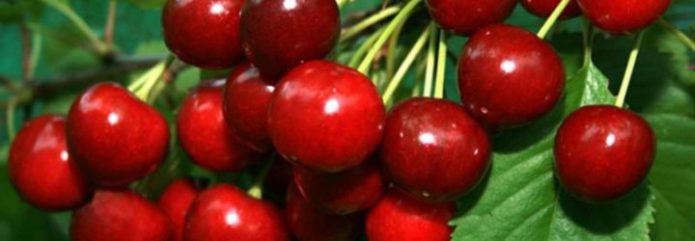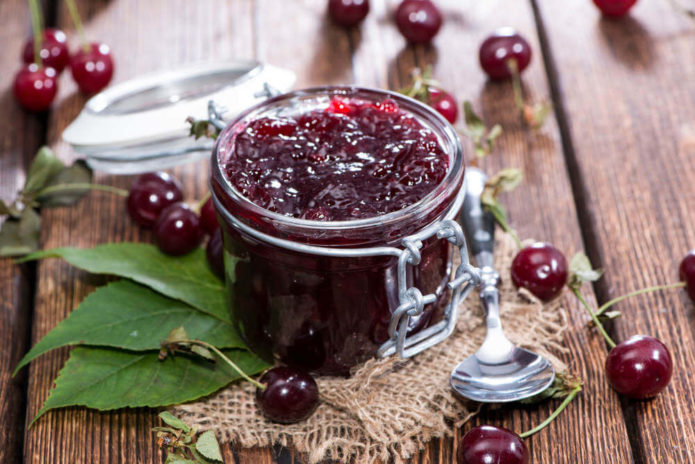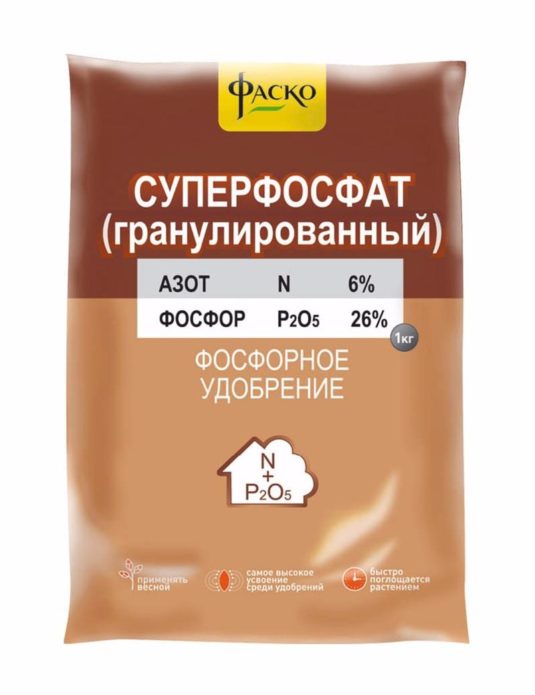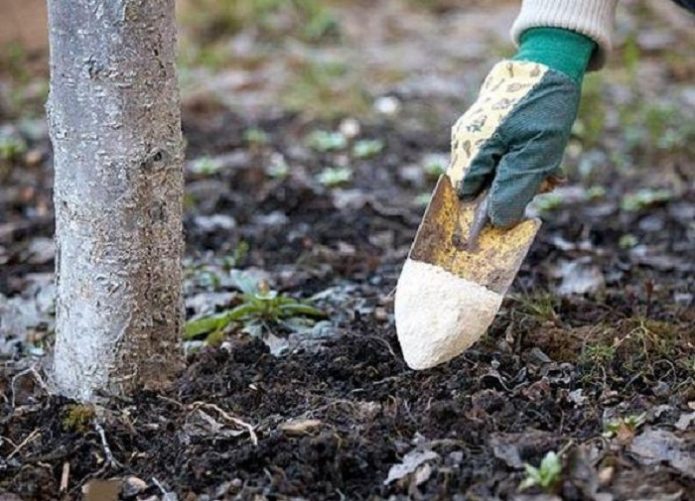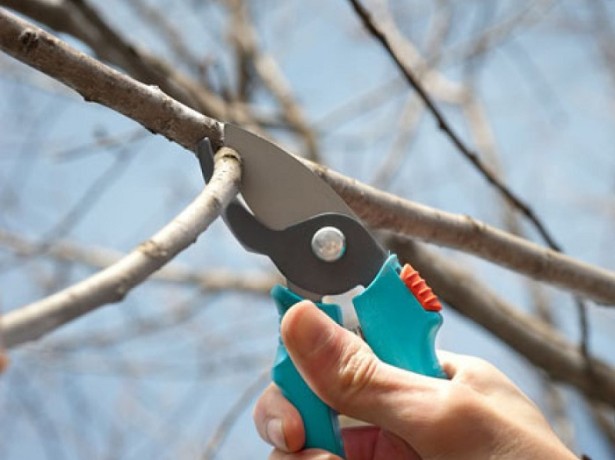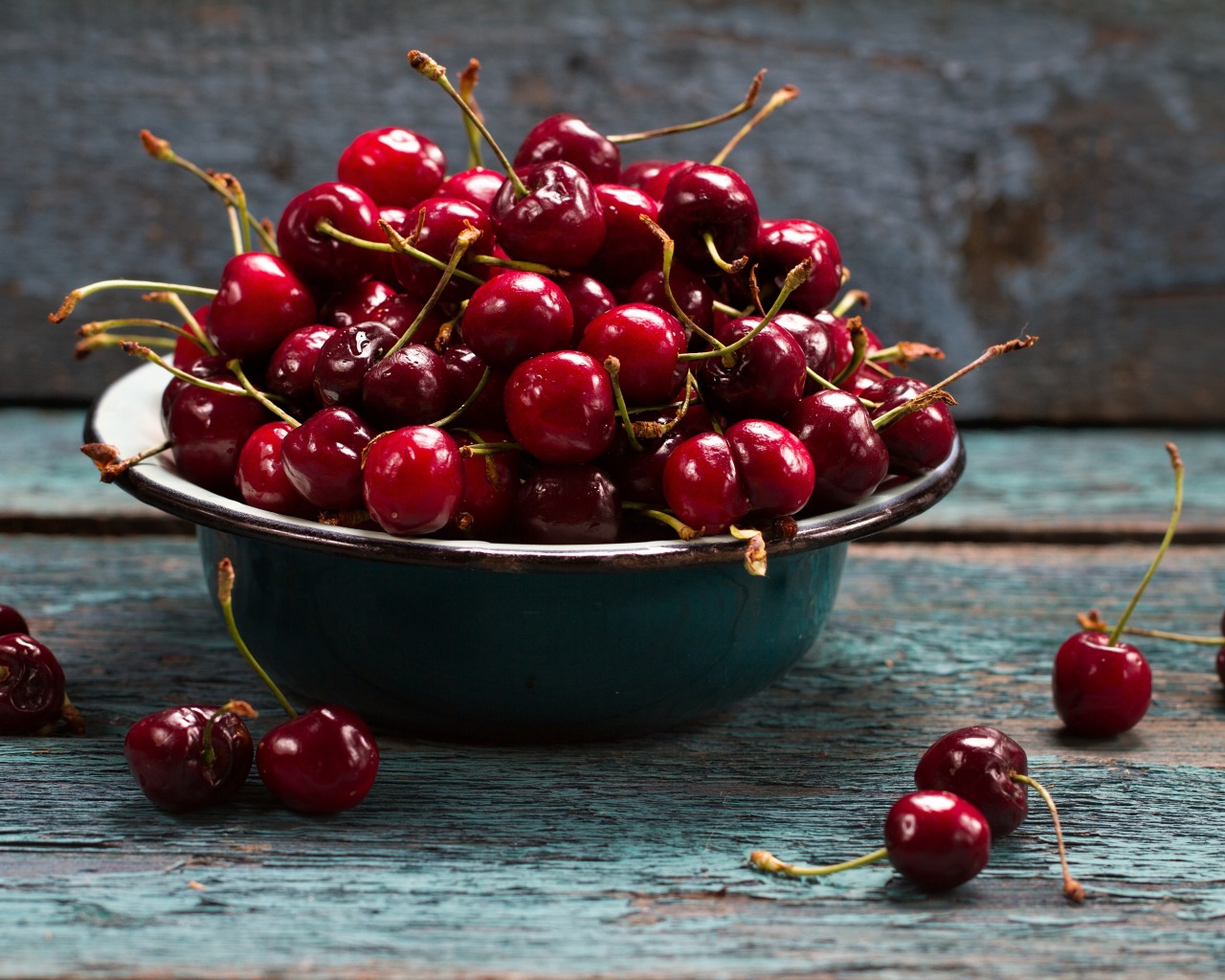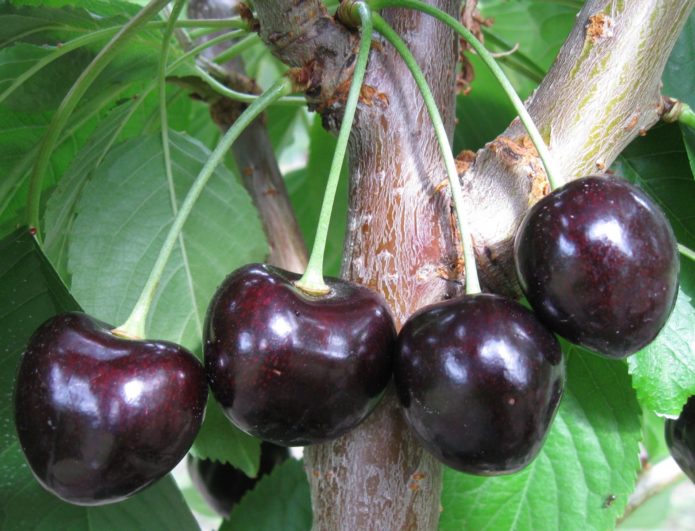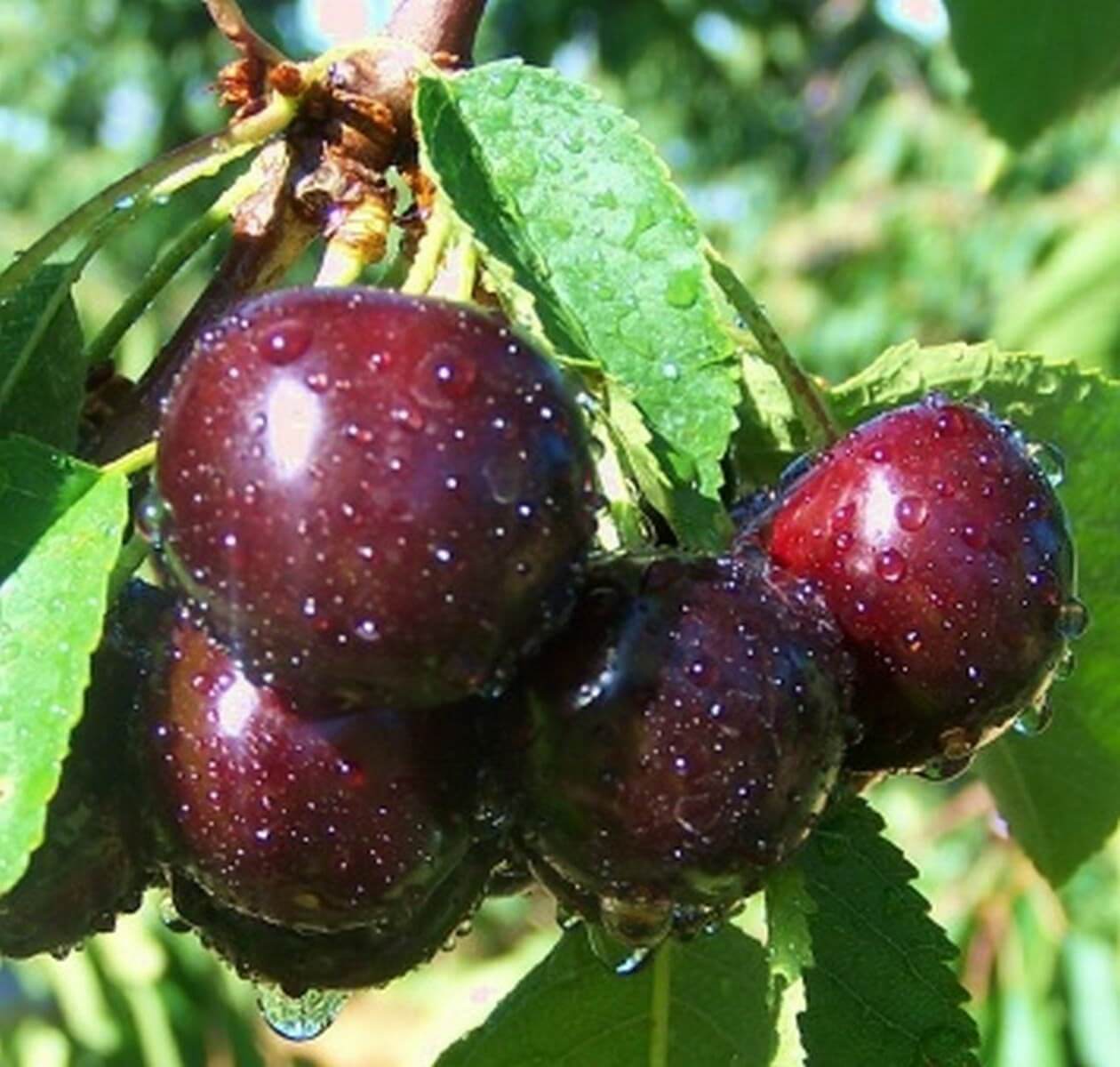Cherry is an indispensable product in our diet. Well, what summer can be without a cold refreshing compote? On a winter evening, we love to enjoy a fragrant sweet and sour cake. To get a decent harvest of tasty and healthy berries on your site, you need to responsibly choose a variety. One of the best is the Kharitonovskaya variety.
Content
Description of Kharitonovskaya cherry
Kharitonovskaya was obtained by crossing the varieties Zhukovskaya and Almaz in 1988. The authors of the hybrid are E. N. Kharitonova and I. S. Zhukov. The main place of growth and zoning of the variety is the Central Black Earth Region.
Kharitonovskaya belongs to mid-season varieties. The crown of the tree is medium thickened, rounded. Shoots are straight, red-brown, leaves are dark green, large. The flowers on the Kharitonovskaya cherry are large and white. The berries are large, juicy, dark red, round, each weighing an average of 4–5 g. The pulp is soft, orange. Kharitonovskaya is partially self-fertile. Cherry varieties Zhukovskaya and Vladimirskaya are excellent pollinators. Begins to bear fruit in the fifth year, the separation of fruits is dry.
Characteristics
The advantages of the Kharitonovskaya variety are resistance to coccomycosis and other fungal diseases, consistently high yield, partial self-fertility, unpretentiousness, relative winter hardiness, large and tasty fruits of excellent presentation.
The main disadvantage is a large bone in the fruit.
Taste qualities
Cherries have a sweet and sour taste. The fruits are eaten raw, and are also great for preparing various spirits, juice, compote, pastries, desserts and jams. Tasters rate the taste of the Kharitonovskaya variety at 4.7 points.
Yield
Cherry Kharitonovskaya is famous for its high and regular harvest. One tree produces 20-25 kg of berries annually.
Disease resistance
Cherry Kharitonovskaya is resistant to fungal diseases. The variety has a particularly high resistance to coccomycosis and moniliosis.
Planting cherry Kharitonovskaya
If you bought a seedling with leaves, remove them, otherwise they can dehydrate the tree. After purchasing a tree, moisten the roots and wrap them with a damp piece of cloth, and on top with a film so that they do not dry out.
Planting time
In the southern and central regions, cherries take root well during autumn planting (in October before the first frost). In the middle lane, in order to avoid freezing of the tree, it is better to plant seedlings in early spring, when the frost is already behind, and the buds have not yet appeared on the trees.
Choosing a place and feeding
Cherry varieties Kharitonovskaya are planted in a lighted place. Avoid planting in low areas, where water can accumulate, which is detrimental to the plant. Groundwater should not be closer than 1.5 m from the soil surface. If they pass close, make a mound for planting.It is appropriate to plant a tree near the walls of a shed or next to a fence so that the cherry is in some shelter from the wind.
Before spring planting, the soil for planting plants is prepared in the fall. Before autumn - 14 days. Podzolic, low-fertile soils are dug up, then the soil is mixed with fertilizers. Organic matter (rotted manure, peat, compost) is applied at the rate of 7 kg per 1 m2, add potassium dressings - 100 g, as well as mineral - 200 g of superphosphate. Light sandy loam soils are dug up together with lime (400 g per 1 m2), heavy loamy requires 600 g of lime. Cherry needs to organize suitable nutrition, so fertilizers are also applied to the hole during planting, but lime or nitrogen-containing dressings will not work for this purpose, they can cause root burns, thereby weakening the plant. Add 10 kg of organic fertilizers, 200 g of superphosphate, 50 g of potassium sulfate or 400–500 g of ash.
Landing technique
When landing, use the following guidelines:
- Dig a hole 55–60 cm deep and 75–80 cm wide. Fold the upper and lower layers of the earth in different directions. Do not forget that trees need free space, so leave 2-3 m between them so that they can grow properly and do not interfere with each other.
- Place a stake at the center of the hole.
- Pour top dressing, on top - fertile soil (top soil removed when digging a hole) with a layer of 6-7 cm. So the seedling will not come into contact with fertilizers and it will not get burns.
- Place a tree in the hole so that the root collar is 4–5 cm above the ground. After several waterings, it will settle down to the ground level (it should be). The root collar covered with earth will rot, the tree will begin to deteriorate. You can also not leave the roots uncovered, they will dry out, and the cherry will die.
- Fill the hole with the remaining soil, straightening the roots and knocking the soil under them, avoiding the formation of voids. Tamp the earth a little, especially at the edges.
- Form a hole around the planted tree. Make a side around the edges, before the onset of winter do not forget to remove it to avoid water accumulation.
- Pour 20 liters of water into the hole and sprinkle with dry soil, peat or humus.
- Tie the tree to the peg with a "figure eight" so that the rope does not cut into the trunk. The stake should be lower than the first skeletal branch, so that when the tree is swayed by the wind, the branches do not rub against it and are not damaged.
- Cut the conductor so that it is 20 cm higher than the ends of the upper branches. Leave 5-7 skeletal branches in a tier.

Place the stake first, then plant the cherry - driving in the peg after planting will damage the roots of the tree
Cherry care Kharitonovskaya
The soil in the near-trunk circle must be loosened once a month. After watering and heavy rains, a crust forms on the soil - it is broken with a rake. In the fall, they dig up the earth in the hole, but not deeper than 10 cm near the trunk, so as not to injure the roots. Weeds are removed - they take away nutrients from the tree, because the cherry's roots are close to the surface of the earth. Due to weeds, the tree grows poorly, gives fewer shoots, and forms fewer ovaries. Overgrowth should also be removed.
Watering
It is recommended to water the cherries 4 times per season:
- after flowering;
- during active growth of branches;
- during the period of fruit ripening;
- when preparing the tree for winter (early October).
With excessive watering, the berries crack.
If the tree is young, 2 buckets of water at a time are enough for it. If the tree is more than three years old, it is watered with 5-7 buckets of water. Water is served in the holes, but it is better to pour the cherries into the circular grooves. They are made along the periphery of the crown 20–25 cm deep. Watering in two furrows will be even more effective. Closer to the trunk at a distance of 45-50 cm from the first groove, a second groove is dug with a depth of 10 cm.
How to fertilize Kharitonovskaya cherry
In the second year after planting, the cherry is in need of feeding.Lack of nutrients causes growth retardation, reddish or purple spots on the leaves, and rapid aging of the tree.
You should not oversaturate cherries with fertilizers - plants that have received an excess of fertilizing have a high probability of freezing in winter.
An approximate scheme for making fertilizing for cherries of the Kharitonovskaya variety looks like this:
- the next year after planting the seedling, in March, 70–100 g of carbamide (urea) is poured under the digging. If the land is fertile, then fertilizers are applied starting from the third year after planting the plant;
- in the third year in early spring, when the threat of frost is over, nitrogen-containing fertilizers dissolved in water are poured into the ring grooves. This can be 20 g of carbamide diluted in 10 liters of water - use half of the solution per tree. If fertilizers were not used in the second year, add 100 g of urea;
- in the fourth year, in the early spring, 180-200 g of carbamide is added to the dug soil. In August or September - 300 g of double superphosphate and 100 g of potassium sulfate. In the middle of autumn, the soil is dug up with the introduction of 20 kg of organic fertilizers;
- for the next two years, the annular grooves are filled with ammophosphate diluted in 10 liters of water (35 g);
- in the seventh year, in the early spring, 300 g of carbamide is poured into the dug soil. In autumn, digging is carried out with the introduction of 350 g of superphosphate and 150 g of potassium sulfate. At the same time of year, 40 kg of rotted horse manure are poured into the ring grooves.
After applying undiluted fertilizers, the soil is thoroughly watered.
Cherries 8 years old and older are fertilized every 2 years with minerals and every 4 years with organic matter. The proportions are the same as for a seven-year-old plant. The soil is limed every 5 years. The amount of lime is determined by the acidity of the soil.
Do not apply lime with nitrogen and organic fertilizers at the same time. This mixture becomes useless for the plant. It does not receive the necessary nutrients, as a result of which the yield decreases.
Pruning
Cherries are cut once a year, in spring - before the sap flow begins. If the plant seems to be frozen, prune it later. As the buds grow, frozen branches will be noticeable. At this time, start pruning by cutting off frost-damaged shoots.
Crown formation begins during planting and in the next 5-6 years. Branches growing upward are cut “into a ring”. Leave those that are directed to the periphery of the crown. With a length of skeletal branches of 0.5 m or more, they are cut off by about a third. The stem - the lower part of the trunk to the first skeletal branch - is left 40–45 cm high.
Video: pruning cherries in spring
Frost protection
The tree must be prepared for the onset of winter. In a year with heavy rainfall, phosphorus-potassium fertilizers should be introduced at the end of summer. In dry times in early October, abundant watering is carried out (10-15 buckets of water per tree), which will help the plant not dry out during frost.
If during the flowering period there is a threat of frost, the cherry in the evening is watered with 5 buckets of water, and the crown is also sprayed with water. The thin ice formed on the branches will save the tree from freezing.
Protect the trunk from frost and rodents by covering the trunk with branches of conifers, burlap, and on top with a metal mesh.
If the cherry is frozen, carefully remove the dead bark with a knife. Treat the bare area with copper sulfate (300 g) diluted in 10 liters of water and cover with paint based on natural linseed oil or garden varnish.
Video: tips for caring for cherries
Gardeners reviews
Kharitonovskaya is beyond praise - tasty, large, though the bone is too large, does not suffer from either moniliosis or coccomycosis, unlike others with the same care. I treat them all with fungicides twice a season. Today I am going to buy a few more seedlings of Kharitonovskaya in the nursery.
Today they took the fruits of the Kharitonovskaya cherry variety. In our area, this is one of the largest-fruited varieties. The largest-fruited variety in my garden this year. The average fruit weight is 5.7 g. The juice is colored, the separation is semi-dry, the stone is large, weighing 0.5 g. The stone separates well from the pulp. The taste is very good, but the variety is inferior in taste to the Assol and Lebedyanskaya varieties. Plants of the Kharitonovskaya variety have increased resistance to moniliosis and coccomycosis. … Kharitonovskaya's tree is 6 years old. I didn't get it under the frost, so I can't give reliable information, but the harvest is annual, growing. More fruit is tied at the bottom of the crown. This year, the first fruits were 6.5 grams.
Zhukovskaya and Kharitonovskaya are growing up with me. Zhukovskaya is not self-fertile, the rest of the characteristics are good, Kharitonovskaya is self-fertile, inter-pollinates with Zhukovskaya, average frost resistance, and a good cherry variety.
Cherry Kharitonovskaya will meet all its positive characteristics if it receives proper care. In general, this variety is not capricious, primarily due to its high resistance to fungal diseases. Follow the simple rules for caring for cherries, and a rich harvest of large juicy berries will not keep you waiting.
